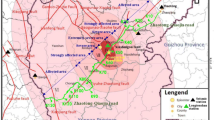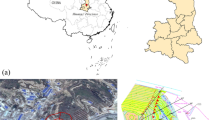Abstract
Since the initial partial impoundment of the Baihetan Hydropower Station in Jinsha River watershed in early April 2021, many landslides have started undergoing rapid deformation. The Wangjiashan landslide has been the most active and dangerous landslide in the Baihetan Reservoir area. Based on road deformation data, the overall average displacement rate of the landslide before impoundment was estimated to be in the range of 11–14 cm/year. After impoundment, particularly after the water level rose to approximately 790 m above sea level (asl) between September to October 2021, the average displacement rate at various monitoring sites ranged from 200 to 600 mm/day, and the maximum value was 1002.6 mm/day. When the water level decreased to approximately 796 m asl, the landslide displacement rate immediately decreased to a range of 2–3 mm/day. The deformation of the Wangjiashan landslide was positively correlated with the rise in water level. The landslide mechanism before impoundment was active–passive failure, and soil mass damage accumulated in the transition zone (Prandtl wedge) between the active and passive blocks. The landslide was strongly affected following reservoir impoundment, with the failure mechanism transforming into a composite active–passive impoundment-accompanied failure. Under the high water level during partial impoundment in 2021, the soil mass in the transition zone of the landslide had yielded and was already in the critical sliding failure stage. Studying the Wangjiashan landslide is significant to understand the response of reservoir-induced landslides in Jinshajiang River valley and similar reservoir-induced landslides around the world.















Similar content being viewed by others
Data Availability
The data underlying this article were provided by China Three Gorges Corporation by permission. Data will be shared on request to the corresponding author with permission of China Three Gorges Corporation.
References
Berilgen MM (2007) Investigation of stability of slopes under drawdown conditions. Comput Geotech 34(2):81–91
Deng J, Wei J, Hong M et al (2005) Response of an old landslide to reservoir filling: a case history. Sci China Series E Technol Sci 48(0z1):27–32
Donati D, Westin AM, Stead D et al (2021) A reinterpretation of the Downie slide (British Columbia, Canada) based on slope damage characterization and subsurface data interpretation. Landslides 18:1561–1583
Eberhardt E, Stead D, Coggan JS (2004) Numerical analysis of initiation and progressive failure in natural rock slopes—the 1991 Randa rockslide. Int J Rock Mech Min Sci 41:69–81
Huadong Engineering Corporation Limited (2020) Engineering geological investigation report on Wangjiashan landslide in the reservoir area of Baihetan Hydropower Station, Jinsha River. China Three Gorges Corporation, Beijing, 2020 (in Chinese).
Hu X, He C, Zhou C, Xu C, Wu S (2019) Model test and numerical analysis on the deformation and stability of a landslide subjected to reservoir filling. Geofluids 2019:1–15
Huang BL, Chen XT(2007) Deformation failure mechanism of Baijiabao landslide in Xiangxi River Valley. Chines Journal of Geotechnical Engineering, 029(006):938-942(in Chinese).
Huang X, Guo F, Deng M et al (2020) Understanding the deformation mechanism and threshold reservoir level of the floating weight-reducing landslide in the Three Gorges Reservoir area. China Landslides 17(12):2879–2894
Jin XG, Li XH, Wang LS (2000) Characteristics of landslide deep displacement curve and stability discriminant. Mountain Research, 5: 440-444 (in Chinese).
Karl T (1950) Mechanism of landslides. The Geological Society of America, Engineering Geology Berkley Volume, pp 83–123
Karl T (1951) Mechanism of landslides. Harvard University, Department of Engineering
Kvapil R, Clew KM (1979) An examination of the Prandtl mechanism in large-dimension slope failures. Trans. Inst. Min. Metall. Sect a: Mining Industry 8:1–5
Lam L, Fredlund DG (1993) A general limit equilibrium model for three-dimensional slope stability analysis. Can Geotech J 30(6):905–919
Lane PA, Griffiths DV (2000) Assessment of stability of slopes under drawdown conditions. J Geotech GeoEnvironmental Eng126(5):443–450
Li SH (2019) Stability of gravel-soil bank slope along Xiaojiang River in Baihetan Reservoir. Chongqing Jiaotong Universtiy, Dissertation for Master Degree, China (in Chinese).
Luo SL, Huang D, Peng JB, Tomas R (2022) Influence of permeability on the stability of dual-structure landslide with different deposit-bedding interface morphology: the case of the Three Gorges Reservoir area. China Engineering Geology 296:106480
Macfarlane DF (2009) Observations and predictions of the behaviour of large, slow-moving landslides in schist, clyde dam reservoir, new zealand. Eng Geol 109(1–2):5–15
Mencl V (1966) Mechanics of landslides with non-circular slip surfaces with special reference to the Vaiont slide. Geotechnique 16(4):329–337
Morgenstern NR, Price VE (1965) The analysis of the stability of general slip surface. Geotechnique 15(1):79–93
Müller L (1987a) The Vajont catastrophe- a personal review. Eng Geol 24:423–444
Müller L (1987b) The Vajont slide. Eng Geol 24(1):513–523
Nam NG (2002) Probabilistic design and risk analysis tor the Duong River Dike in the Red River Delta in Vietnam. Hydraulic Engineering Reports, IHE Delft.
Paronuzzi P, Bolla A, Rigo E (2016) Brittle and ductile behavior in deep-seated landslides: learning from the Vajont experience. Rock Mech Rock Eng 49(6):2389–2411
Riemer W (1992) Landslides and reservoirs. In: Proceedings of the 6th International Symposium on landslides. Rotterdam: A.A. Balkema.
Sarma SK (1979) Stability analysis of embankments and slopes. J Geotech Eng Div ASCE 105(GT12):1511–1534
Semenza E, Ghirotti M (2000) History of the 1963 Vajont slide: the importance of geological factors. Bull Eng Geol Environ 59:87–97
Stead D, Eberhardt E, Coggan JS (2006) Developments in the characterization of complex rock slope deformation and failure using numerical modelling techniques. Eng Geol 83:217–235
Tang MG, Xu Q, He Y et al (2019) Activity law and hydraulics mechanism of landslides with different sliding surface and permeability in the Three Gorges Reservoir Area. China Eng Geol 260(3):105212
Wang FW, Zhang YM, Huo ZT et al (2008) Mechanism for the rapid motion of the Qianjiangping landslide during reactivation by the first impoundment of the Three Gorges Dam reservoir. China Landslides 5(4):379–386
Wei JB, Zheng HC (2012) Deformation characteristics of a preexisting landslide in reservoir area during reservoir filling and operation. Advanced Materials Research, 518-523: 4675-4679.
Wu SS, Hu XL, Zheng WB, Zhang GC, Liu C, Xu C, Zhang H, Liu ZX(2022) Displacement behaviour and potential impulse waves of the Gapa landslide subjected to the Jinping Reservoir fluctuations in Southwest China. Geomorphology 397:108013
Yin YP, Huang BP, Chen XT, Liu GN, Wang SC (2015) Numerical analysis on wave generated by the Qianjiangping landslide in Three Gorges Reservoir, China. Landslides, 12: 355-364.
Acknowledgements
The authors would like to thank Wang Meng from Sichuan Geological Survey Institute, Zhao Chaoying from Changan University, and Yao Xin from Institute of Geomechanics, Chinese Academy of Geological Sciences. They were of great help in providing the historical remote sensing image of the Wangjiashan landslide.
Funding
This work was supported by the China Three Gorges Corporation (YM(BHT)/(22)022).
Author information
Authors and Affiliations
Corresponding author
Ethics declarations
Competing interests
The authors declare no competing interests.
Rights and permissions
Springer Nature or its licensor (e.g. a society or other partner) holds exclusive rights to this article under a publishing agreement with the author(s) or other rightsholder(s); author self-archiving of the accepted manuscript version of this article is solely governed by the terms of such publishing agreement and applicable law.
About this article
Cite this article
Xiaoting, C., Renjiang, L., Bin, H. et al. Deformation response and mechanical analysis of the Wangjiashan landslide in Baihetan Hydropower Station, China, during initial impoundment. Bull Eng Geol Environ 82, 344 (2023). https://doi.org/10.1007/s10064-023-03361-7
Received:
Accepted:
Published:
DOI: https://doi.org/10.1007/s10064-023-03361-7




